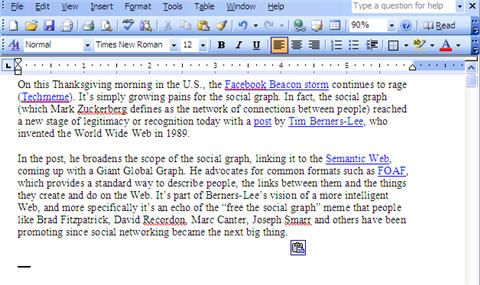Live Documents enters the Office suite ring

Sabeer Bhatia was the co-founder of Hotmail, the Web email service Microsoft acquired for $400 million in 1998. Now, Bhatia wants to bite the hand that fed him. He formed a new company, InstaColl, and is joining Zoho, ThinkFree, Google, Yahoo (Zimbra), Adobe and lesser know others in the effort to squish Microsoft Office with a new suite and complementary collaborative component, Live Documents.
Live Documents is a set of Flash-based Office 2007-like applications and also embeds collaborative capabilities and adds online/offline synchronization into Microsoft Office documents.
Bhatia said, "We are just a few years away from the end of the shrink-wrapped software business. By 2010, people will not be buying software. This is a significant challenge to a proportion of Microsoft’s revenues.”
His claim that no one will be buying shrink-wrapped software in a few years sounds like he is channeling salesforce.com's Marc Benioff, who has been making that call for several years. The idea of software moving mainly to the cloud and collaboration is a logical outcome based on what is going on today, but not in the time frame he suggests.
At this point the Office competitors are ankle biters, pesky critters getting Microsoft's attention but not affecting the bottom line. NPD reports that Office 2007 accounts for 17.4 percent of all PC software dollar volume and retail sales the suite are about double the rate of Office 2003 at a similar post-launch stage.
Google Apps has millions of users, but most are not paying or using it corporate settings. Google distribution partner CapGemini recently touted its first corporate $50 per user per year Google Apps customer--165 of its own users. Zoho has less than 500,000 users of its array of browser-based applications. Microsoft has hundreds of millions of Office users.
And, as I wrote earlier this week, the shift from shrink wrapped software to "live" services is not unknown to Microsoft. The company probably has something similar to what Live Documents has developed waiting in the wings for the day, or year, when the balance shifts and Google Apps or another suite becomes more than an ankle biter. For example, Microsoft is developing a Sync Framework for adding synchronization, roaming, and offline capabilities to applications, and using any data type, data store, transfer protocol, or network topology.
If Microsoft has its head in the sand, as Bhatia seems to think, then he may have another big payday ahead from Microsoft (he would have to recode the interface in Silverlight to make Microsoft happy). With the name Live Documents, it fits perfectly into Microsoft's "Live" world.
The key features of the ankle biters is that they are mostly free and built from the ground up for collaboration. Microsoft Office documents use the old email sharing model. InstaColl describes its offering as a "software plus services" value proposition, using Microsoft's way of characterizing its approach to marrying the client and the Web.
Following is a description of Live Documents:
Live Documents is a full-featured suite of online Office productivity applications offering functionality equivalent to Word, Excel and PowerPoint. Built using RIA technologies such as Flash and Flex, Live Documents allow users to view and edit documents within any common browser on any operating system from anywhere. Live Documents uses a Flash-based user interface that offers a richer and responsive user experience that is comparable to native Office software applications.
In addition, Live Documents is available as a optional desktop client application that wraps around Microsoft Office and embeds collaborative capabilities into these hitherto standalone software applications - Live Documents converts Microsoft Office applications from static standalone software to smart clients that are connected to the Internet and facilitate in-context document sharing (multiple people can edit a document at the same time) and management (security, access control and revision control) without requiring users to give up their familiar user interfaces. The Live Documents desktop client also ensures offline access to documents - a key failing of current online Office applications.
The service is not live (you can request an invite, which I did) and the site doesn't contain any screen shots. It's not very credible to talk about breaking Microsoft's proprietary format lock-in and matches features found in Office 2007, which IntaColl CTO Adarsh Kini does on the Web site, without showing anything, not even a tour, of the service.
For reference, following are what the rest of the field looks like. ThinkFree, for example, has focused on being Microsoft Office-like in its appearance and features, while others, such as Google Apps, are taking a simpler approach currently, appealing to users who don't need the sophisticated features of Office. Zoho has build a vast suite of more than a dozen applications with increasingly sophisticated features. And all of the online applications providers are introducing offline capabilities. Zoho, for example, has already deployed Google Gears in Zoho Writer for offline usage and synchronization.
What's clear is that Microsoft Office is a justifiably huge target for competitors, a $16 billion business. Bandwidth, browser technology, development tools, infrastructure costs and user expectations are enabling more sophisticated applications to live on the Net.
Live Documents sounds like an interesting new entrant, especially the "embrace and extend" capability to make the existing Microsoft Office applications collaborative without SharePoint. We'll have to wait and see whether it can live up to the hype.
